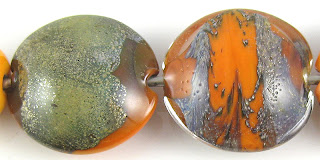1 - Plain, 2 - Plain (reduced), 3 - w/ Silver Leaf, 4 - w/ Silver Leaf (reduced & encased), 5 - w/ TerraNova2 Frit, 6 - w/ Silver Glass Frit (reduced), 7 - w/ Tuxedo, 8 - w/ Copper Green, 9 - w/ Opal Yellow, 10 - w/ Ivory, 11 - w/ Peace
Effetre Lizard is one of those colours that you just can't get to know intimately after just one date. It feels like a slightly unholy mixture of Mud Slide and Dark Matter, both of which I like very much. A couple of my Lizard rods have been a little shocky, but on the whole, it is pleasant to use. It seems to have enormous potential, and it is definitely unique in the 104 palette. I have fallen enough in love with this colour that I've built a small stockpile of it, since it seems to be one of the question marks in terms of whether or not there will be a regular supply of it once Mike Frantz has sold all of his stock. I guess I should ask.
Lizard is very reactive, and it's a striking colour. Repeated heating and/or the addition of silver both make Lizard browner and darker. You can see above how my lentils and spacers are much darker in colour than the bicolor ovals that I made in the lower row of beads. I made the two spacers on the same mandrel, but only reduced one of them and you can see that the one I did not reduce looks significantly greyer than the one I did reduce. I like the earthy grey of the unreduced spacer almost as much as the rich brown of the reduced one, so it's nice that I can have both.
In the bead on the left, the silver leaf has turned yellowish on top of the Lizard, and the base bead has fumed/struck a rich brown colour. When this reaction was reduced and encased, the Lizard seems to have gone almost purple in places and the silver leaf has a mottled but blue-ish sheen to it under the encasement layer. A thin layer of yellow 'crud' is also visible on top of this reaction.
Lizard is yummy with silver glass. In the bead on the left, where I did not overstrike the TerraNova2 frit, you can see the pretty colours. It is also interesting how the Lizard is greyer and lighter in the middle of this bead, near the frit, than it is at the ends. In the bead on the right, the Lizard has developed a bit of a patina, and looks almost yellowish brown around the frit and dark grey at the ends. The reduced silver glass frit on top of the Lizard has a strange, mottled look to it. Me likes.
Lizard and Copper Green have a reciprocal dark line reaction, and you can see on the right side of the bead that the Copper Green dots and stringer lines also have a sort of brownish blush around their edges and seem to float just slightly on top of the Lizard.
On top of Opal Yellow, Lizard separates a little at the edges of dots and stringer lines, leaving a brownish residue. The Lizard also seems to coagulate in the centre of the stringer lines, looking much darker in hue there. On top of Lizard, Opal Yellow develops a thin dark outline and on both sides of the bead, the Opal Yellow has blushed a rich yellow with some darker, mustardy mottling.
On top of Ivory, Lizard's outline is sort of translucent, and the Lizard has the appearance of floating slightly on top of the Ivory glass. It also looks pretty brown on top of Ivory. Under Ivory, the Lizard has separated slightly in spots, giving the appearance of cracks in the surface (although there aren't any).
Peace lines and dots on top of Lizard separate slightly, forming some translucency at their centre. On top of Peace, Lizard spreads and develops a yellowish outline that contributes to the illusion that the Lizard lines are three dimensional.
I have made a lot of beads with Lizard, but I apparently haven't taken pictures of any of them. If that changes in the next little while, I will come back and update with pics. Lizard is making a fabulous 'earth' colour for the ground in my new mushroom focal design.

































